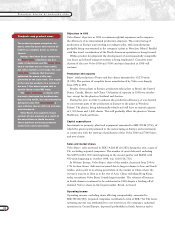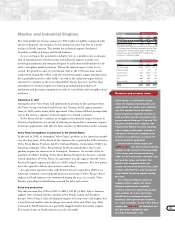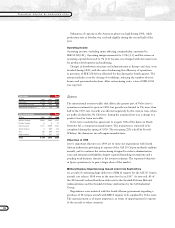Volvo 1998 Annual Report Download - page 41
Download and view the complete annual report
Please find page 41 of the 1998 Volvo annual report below. You can navigate through the pages in the report by either clicking on the pages listed below, or by using the keyword search tool below to find specific information within the annual report.
39
Parts of the sales-finance operations give
rise to specific credit and residual-value
risks.
Credit risk in sales financing
The credit risk in sales financing is distrib-
uted among a large number of individual
end-customers and dealers. Collateral is
provided in the form of the products being
financed. When issuing credit, an effort is
made to balance risk exposure and
expected yield. Operations are governed
by common policies for credits and by
rules for classifying customers. The credit
portfolio should be distributed properly
among different categories of customers
and different industries. Credit risks are
managed through active monitoring and
follow-up procedures and, in appropriate
cases, procedures for repossessing
products. Allocations are also made to
credit risk reserves.
Residual-value risk in sales-financing
Residual-value risk is attributable
primarily to contracts involving oper-
ational leasing. It comprises the risk that
the leasing object, at the end of the oper-
ational leasing contract, has another
residual value than foreseen when the
contract was concluded. This may force
the lessor to dispose of products at a loss.
Residual-value risks are managed through
solid knowledge of the market, knowledge
of product and price trends, and programs
supporting the value of second-hand prod-
ucts. Provisions are also made in residual-
value reserves for any differences between
anticipated and actual residual values.
Interest-rate and liquidity risk
in sales financing
Changes in interest rates during the
period covered by a contract can affect
income. Therefore, efforts are made to
match the fixed-interest-rate periods for
borrowing and lending. The degree of
matching at year-end 1998 was approxi-
mately 90%.
In a corresponding manner, the
maturity of the borrowing shall correlate
with the maturity of the outstanding
contract. This degree of matching was
also about 90% at year-end 1998.
Risk exposure
Trend of income
Operating income from sales-financing companies amounted to SEK 470 M
(202), of which SEK 272 M (89) was attributable to Cars and SEK 198 M (113)
to the commercial products sector. The trend of operating income in the estab-
lished sales-finance companies was positive with respect to both Cars and the
commercial products sector. Return on shareholders' equity for the established
companies was in line with the return demands of the Volvo Group. Companies
that began operations more recently and which have high rates of growth were
also charged with start-up costs, as well as costs of building up the required
credit and residual value reserves.
Income from investments in associated companies totaled SEK 109 M (146),
and consisted mainly of income from participations in AB Volvofinans.
The income of Transbanco, which conducts sales financing of Volvo's trucks
and buses in Brazil, improved during 1998. The number of new credit contracts
signed was limited.
Provision for risks
Provision is made for both credit risks and residual value risks to the degree that
residual value risks are attributable to the sales-financing company. In the case of
customers who cannot fulfill their contractual obligations, specific provisions,
based on individual assessment, are made for credit and residual value risks. In
addition, in accordance with established policies, general provisions are made
for credit and residual value risks in each sales financing company, based on
historical data and anticipated future risk. At year-end 1998, general provisions
for credit and residual value risks in sales financing companies amounted to 2.2%
(2.2) of the credit portfolio. Realized credit losses which were charged against
operating income, amounted to 0.3% (0.2) of the credit portfolio in 1998.
There are also provisions for residual value risks in a number of marketing
companies that have made guarantees and/or have signed repurchasing contracts
with sales-financing companies.
Because the sales-financing operations involve substantial financial exposure
in individual countries, a central provision of SEK 225 M (300) has also been
built up. Allocations to and reversal of the central reserve were not charged
against income from sales financing. Reversal of SEK 75 M during 1998 was
justified by a more stable provisions level within the sales-financing companies.
The central reserve amounted to 0.3% (0.7) of the credit portfolio at year-end
1998.
























